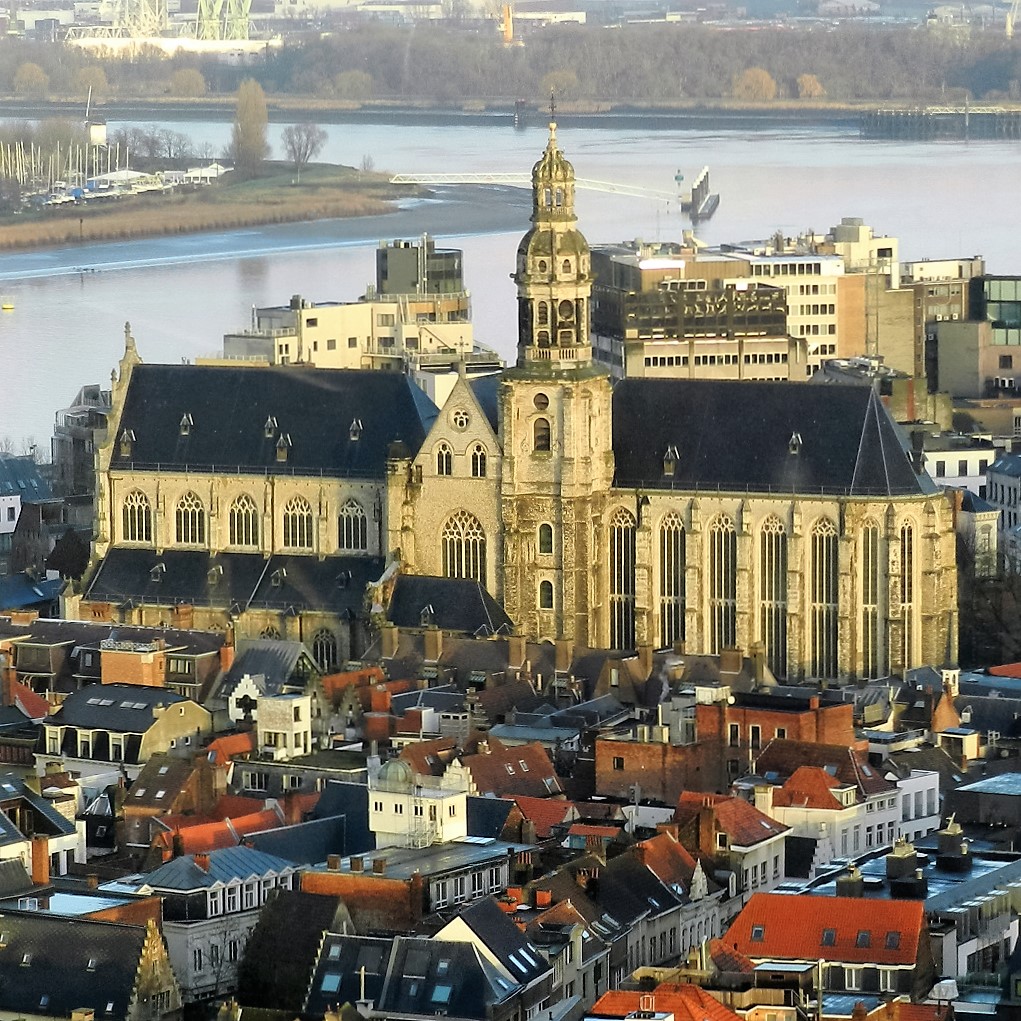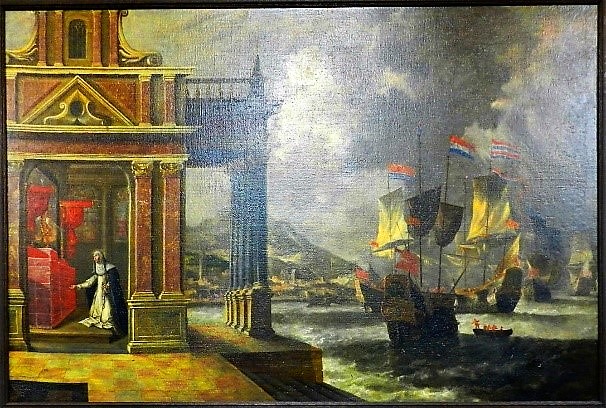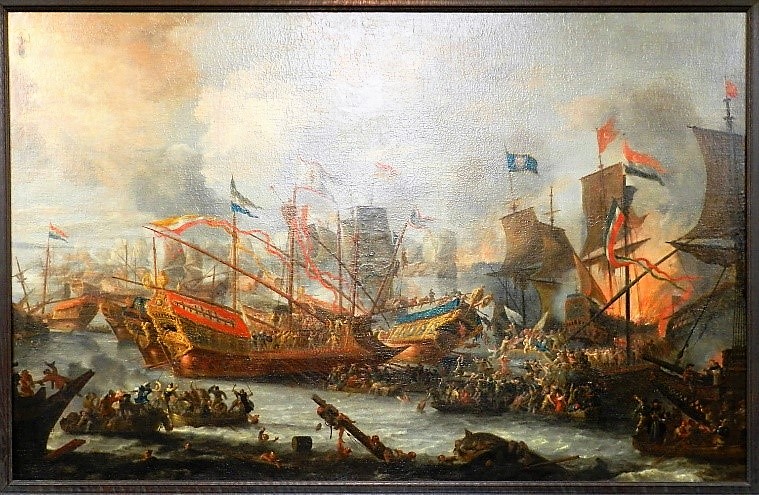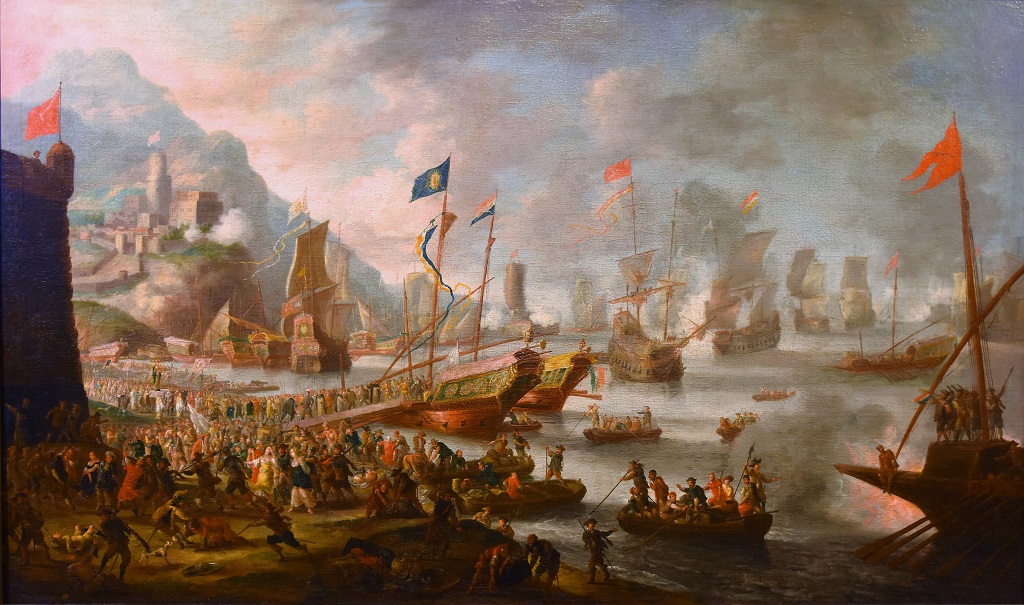Saint Paul’s, the Antwerp Dominican church, a revelation
The paintings in the cloisters
The Naval battle of Lepanto
(Jan Peeters, 1665-1672)
When the Ottoman fleet, commanded by Ali Pasha, threatened Europe, a ‘Holy Alliance’ to protect Christianity was concluded by pope Pius V, Spain, Venice, Genoa and Malta (the Knights Hospitaller). On October 7th 1571, the allied fleets, commanded by Don John of Austria, vanquished the Islamic fleet, which was larger and thought to be invincible, in one of the biggest naval battles in history, near Lepanto (now Návpaktos). The Dominican pope Pius V attributed the victory of the Western Alliance to praying the rosary. The Dominicans, who were present at the naval battle as army chaplains, revealed themselves as the main promoters of the rosary. After all, the best way to cope with the battle against evil is prayer.
At the occasion of the first centennial of the naval battle, the Brotherhood of the Rosary, which also celebrated their jubilee, commissioned four scenes of The Naval Battle of Lepanto for their chapel
A small church that is not a parish church. It may be part of a larger entity such as a hospital, school, or an alms-house, or it may stand alone.
An enclosed part of a church with its own altar.
. They were all signed and dated by the painter.
1. The preparation:
the supplication and the embarkation (1671)
On the left, in the vista of a Renaissance church, there is a female saintThis is a title that the Church bestows on a deceased person who has lived a particularly righteous and faithful life. In the Roman Catholic and Orthodox Church, saints may be venerated (not worshipped). Several saints are also martyrs. in the Dominican habitGeneral name for the typical clothing of a particular religious order.
A long-sleeved, unbuttoned robe down to the feet, usually with a hood attached. This attire is typical of monks and nuns.
. She is on her knees in front of the Holy SacramentIn Christianity, this is a sacred act in which God comes to man. Sacraments mark important moments in human life. In the Catholic Church, there are seven sacraments: baptism, confession, Eucharist, confirmation, anointing of the sick, marriage and ordination., praying the rosary to a successful result of the decisive sea battle. This was requested by the Dominican pope Pius V. The saint in question is Catherine of Siena, a member of the third order, who is considered to be the prototype of Dominican holiness, especially of contemplative nuns. Whereas in the next scenes the focus is on the male members of the order, here the female order is in the foreground, which could be seen as a wink to the Antwerp conventComplex of buildings in which members of a religious order live together. They follow the rule of their founder. The oldest monastic orders are the Carthusians, Dominicans, Franciscans, and Augustinians [and their female counterparts]. Note: Benedictines, Premonstratensians, and Cistercians [and their female counterparts] live in abbeys; Jesuits in houses. of Dominican sisters, which was devoted to Catherine of Siena and was nearby, in Predikerinnenstraat. But the main reason of her presence is that Pius V was said to have had a vision in which Catherine would have advised this ‘crusade’. In the background the Greek Lepanto looks like a town of the Southern Low Countries with stepped gables and Gothic churches. From the quay the Christian troops embark.
2. The naval battle (1671)
The battle is still raging with full violence, but it is clear that the Christians are winning. The Ottoman fleet can be recognized by their red flags with a white crescent moon. In the middle the Spanish flagship, with an image of Our Lady on the white banner, rams the Ottoman flagship. A sailor triumphantly shows Ali Pasha’s decapitated head on a stake. On board the ships and sloops Dominicans, armed with crucifixes and rosaries, offer spiritual support; one of them even steers the Spanish flagship. Above the turmoil of war Our Lady and Child appear, to show who is winning the battle for salvation.
3. The victory (1665)
After his victory Don John of Austria goes ashore. Without hesitating the Dominicans organize a public expression of gratitude in the form of a procession in honour of Our Lady of the Rosary. Bottom left: on the shore a few ‘Turks’ have been taken prisoner and are carried off heavy-handedly. Two voluptuous young women and a third one are taken in: the whores or the harem of Ali Pasha? Soldiers loose off volleys of joy.
4. Pope Pius V saying prayer of thanks (1672)
Long before a messenger reaches Rome, on the day of the sea battle itself a miraculous inspiration informs Pope Pius V of the prosperous conclusion, which is depicted in the background. Both fleets are still facing each other in battle array, while the fight between a few ships is situated in the centre. In the foreground Pope Pius V is on his knees praying the rosary. With this he thanks Mary for the victory, which he ascribes to the power of the continuous prayer of the rosary. He founded the feast of Our Lady of Victory, which was soon called ‘Our Lady of the Rosary’. The fact the Pope has no nimbus indicates that the painting was made before he was beatified later that same year. The Pope’s coat of arms, as a member of the Ghislieri family, decorates the chapel.
In the same way as in the first scene a Dominican nunFemale member of a religious order implores the victory by her prayer, in the last scene a Dominican, Pope Pius V, thanks for the victory. In other words the first and the last scenes constitute an inclusion, which is also emphasized by the composition by putting the praying figure in front of an altarThe altar is the central piece of furniture used in the Eucharist. Originally, an altar used to be a sacrificial table. This fits in with the theological view that Jesus sacrificed himself, through his death on the cross, to redeem mankind, as symbolically depicted in the painting “The Adoration of the Lamb” by the Van Eyck brothers. In modern times the altar is often described as “the table of the Lord”. Here the altar refers to the table at which Jesus and his disciples were seated at the institution of the Eucharist during the Last Supper. Just as Jesus and his disciples did then, the priest and the faithful gather around this table with bread and wine. in a chapel, the first one on the extreme left, the latter on the extreme right. In this way the entire report of the victorious naval battle is framed by the rosary prayer.
The Adoration of the Shepherds
(copy from Abraham Bloemaert’s workshop, 17th century)
Joseph looks at the spectator and also points at the Child. Mary, with a Renaissance aureole, proudly and with a tender look ‘unveils’ her Child to the shepherds, who are very interested. The shepherd in the front has a shepherd’s crook to stop sheep to restrain sheep by touching their feet. The second shepherd, with a straw hat, leans on a cane. The youngest shepherd, in the background, carries a small shepherd’s spade on his shoulder, with which a ball of soil is thrown to stop a sheep running away. Among the offerings there are a rooster and a hen whose feet have been tied. The sheepdog stares us straight into the eyes.
The Antwerp bishopPriest in charge of a diocese. See also ‘archbishop’. Reginaldus Cools o.p.
(anonymous, 17th century)
This 17th century canvas is an official portrait such as those commissioned by important ecclesiastic institutions or given to them as a present to emphasize the bishop’s authority.
Daniel Cools (° 1618) was first ensign in the Spanish army and afterwards secretary to a lawyer. In 1645, after a life of adventure, he joined the Dominicans and received Reginaldus as his convent name. In Spain he was the spiritual advisor of the queen and a close friend of king Philip IV, who sent him to Louis XIV’s court as an envoy. After he had been bishop of Roermond for nearly thirty years, he was appointed tenth bishop of Antwerp in 1700. At the occasion of his induction he walked from the Dominican convent to the CathedralThe main church of a diocese, where the bishop’s seat is. in procession. Because the precious metal crosier they had borrowed from the abbotThe man who has been chosen by the abbey community of which he is a member to lead that community for a fixed period. of Pieter Pots AbbeyA set of buildings used by monks or nuns. Only Cistercians, Benedictines, Norbertines and Trappists have abbeys. An abbey strives to be self-sufficient. turned out to be too heavy for this old man, he took the wooden crosier from Ophovius’ tomb. Because it was so worm-eaten the crook fell off on the way, which did not prevent Cools from continuing his route with the staff. The Antwerpians said to each other: “There was a time when we had wooden bishops with golden crosiers, now we have a golden bishop with a wooden crosier.” He died in 1706.
The image of Mary and Child that offers a rosary, illustrates the devotion for the Rosary. Beneath the escutcheon one can read his motto “non nobis” (we do not do it for ourselves).
Christ visiting Martha and Mary
(Abraham Janssen Van Nuyssen, 1627)
Jesus is a guest in Martha’s and Mary’s house (Lk. 10:38:42). He is outside in the courtyard, with a wonderful view (by Jan Wildens) on a French garden with a large pond. Mary looks very much like an aristocratic lady, with a strikingly pale complexion and wearing rich and elegant clothes. She listens to Jesus attentively, with an open book in her lap. Martha is in the shadow, but still the colour of her skin is darker and she wears simple clothes as those of a kitchen maid. In a masterly way elements of genre art are used here to tell the story. The vegetables on a kitchen table (with a drawer) behind her suggest that she is very busy preparing the meal. She does not put up with the fact that Mary leaves all the work to her. This is why she complains to Jesus about her sister.
Indignantly she points at the hare and the poultry in a basket, as if she is saying: “Look, what has to be done!” But we know how the story continues. Jesus does not rebuke Mary, but Martha learns that she is too much preoccupied with material things, while her sister is praised for her longing for spiritual matters, after God’s word.
Painting with the coat of arms of Cornelius Jozef Peltiers
(anonymus, 18th century)
An angel acts as a supporter. Both for his escutcheon and for his motto Peltiers wanted to allude to his own name, which has the meaning of furrier or skinner (from French ‘pelle-tier’). In the upper field an ermine (with skin or fur) is running. while the bottom field completely consists of ermine fur. Beneath there is his motto: “PELLEM PRO PELLE” (skin for skin), a quotation from the Vulgate, from the book of Job (2:4). When Job loses his complete household, he remains faithful to God. The devil claims that this willingness to lose everything can only be motivated by the need to save his own skin. In a second ordeal Job is touched in his health and his skin is covered from head to toe with malignant ulcers.
From both images in the escutcheon Peltiers’s motto can be understood more easily: ‘my skin for a fur’, from the point of view of the ermine in the upper field: ‘my selflessness for a higher goal’, the high quality product which is the ermine fur in the bottom field.
“F: CORNELIUS IOS: PELTIERS S: ORD:
PRAED: IN ALMA UNIV: LOV: S:TH: LICENTIATUS DIE 26 JAN: 1773.”
The Kinship of Mary
(Marten Pepijn, end 16th – beginning 17th century)
 ‘The Kinship of Mary’ is better known as ‘The Kinship of Saint Anne’. It is a typically medieval theme that prefers emphasizing the wider family relations in times when the individual family was not yet so much in the foreground. Most members of Mary’s family mentioned however are only based on apocryphal traditions.
‘The Kinship of Mary’ is better known as ‘The Kinship of Saint Anne’. It is a typically medieval theme that prefers emphasizing the wider family relations in times when the individual family was not yet so much in the foreground. Most members of Mary’s family mentioned however are only based on apocryphal traditions.
Medieval legends were fond of constructing stories on these traditions, which resulted in an elaborate genealogical tree. Anne married successively Joachim, Clopas and Salomas. From each of these marriages one daughter was born: Mary, Mary of Clopas and Mary Salomæ.
Because of the apocryphal character of the theme the representation was forbidden by the CouncilA large meeting of ecclesiastical office holders, mainly bishops, presided by the pope, to make decisions concerning faith, church customs, etc. A council is usually named after the place where it was held. Examples: the Council of Trent [1645-1653] and the Second Vatican Council [1962-1965], which is also the last council for the time being. of Trent (1545-1563), but apparently the power of tradition was still too strong to obey this cold ecclesiastic prescription.
Mary is holding the Child on her lap, who stretches out his arms towards granny Anne, who hands Him an apple. In a natural affective gesture Jesus holds His right hand round granny’s thumb. Elisabeth supports her son John the Baptist. Her husband Zachariah is reading a book, together with Saint Joseph, who is younger. The crowning with joyful angels in Heaven was added when the original central panel of a triptych was adapted into a portico altar.
The painter and his wife were buried in Saint Paul’s church.
The interior of Saint Walburga church
(Antoon Günther Gheringh, 1661).
 As an heir of the former parish church Saint Paul’s came into the possession of this painting, one of the few church interiors of the demolished church. In the 19 steps high sanctuary there is the then high altar with the triptych of The Raising of the Cross (P.P. Rubens, 1609-1610). As a successor of the former Saint Walburga parish Rubens’s The Raising of the Cross came to Saint Paul’s, but because of lack of space the gigantic triptych was positioned in Our Lady’s church as a counterpart of The Descent from the Cross.
As an heir of the former parish church Saint Paul’s came into the possession of this painting, one of the few church interiors of the demolished church. In the 19 steps high sanctuary there is the then high altar with the triptych of The Raising of the Cross (P.P. Rubens, 1609-1610). As a successor of the former Saint Walburga parish Rubens’s The Raising of the Cross came to Saint Paul’s, but because of lack of space the gigantic triptych was positioned in Our Lady’s church as a counterpart of The Descent from the Cross.
The return of the Ark of the Covenant
(surroundings of Balthasar Paul Ommeganck,
end 18th – beginning 19th century), panel.
The Ark of the Covenant was the most sacred object in Jewish religion, because in this chest the two stone tablets were kept in which the Ten Commandments had been inscribed: the Covenant between God and His people. When the Philistines seized the Ark from the Jews, they went through a period of all kinds of calamities (1 Sam. 5). This is why they decided to get rid of the Ark. The team of cows smoothly find the track into Jewish land.
Three grisailles in floral wreaths
These three grisailles seem to belong together. The presentation and Christ in Getsemane (Jan Baptist II Bosschaert, 1667-1746), were part of the series of 15 Mysteries of the Rosary that used to be in the chapel of the same name in the convent. Possibly also the canvas Saint Dominic in a floral wreath (Pieter III Casteels, 18th century) belonged there, just as the panel of Our Lady in a floral wreath (anonymous, 17th century).
Christ with mocking cape
(attributed to Otto Van Veen, about 1620?)
Panel with a sculpted frame. It was a painting for the funeral monument of the centenarian Peeter Marcelis (†1652) and Anna Gossaert.






